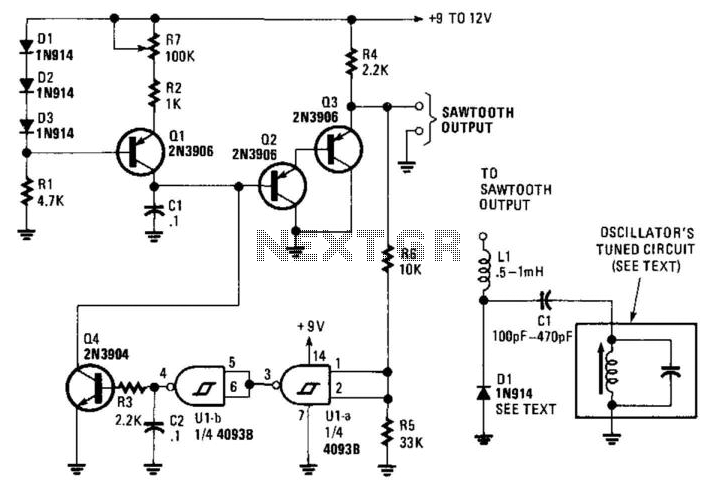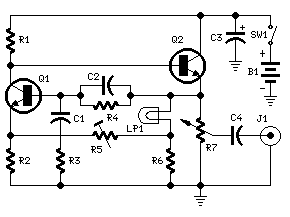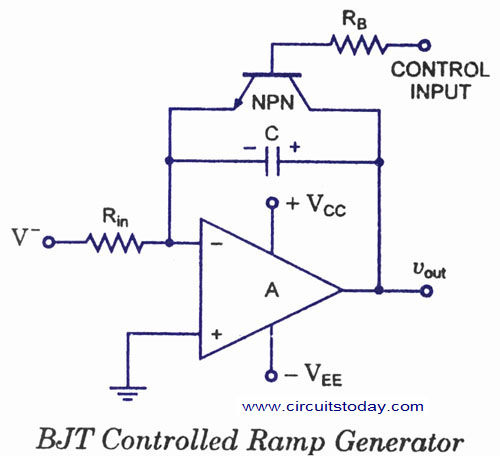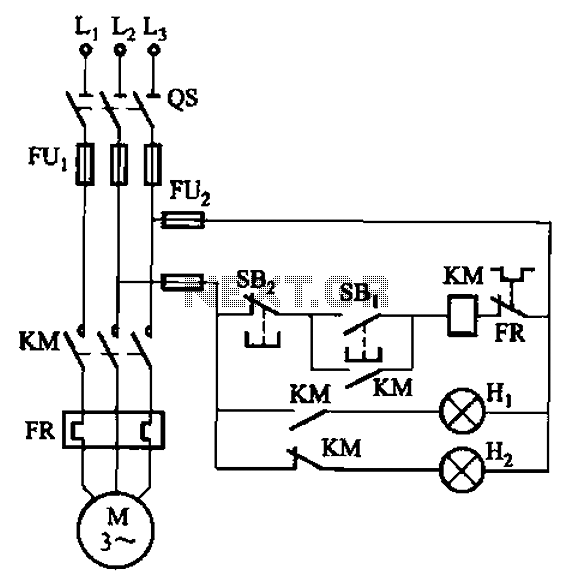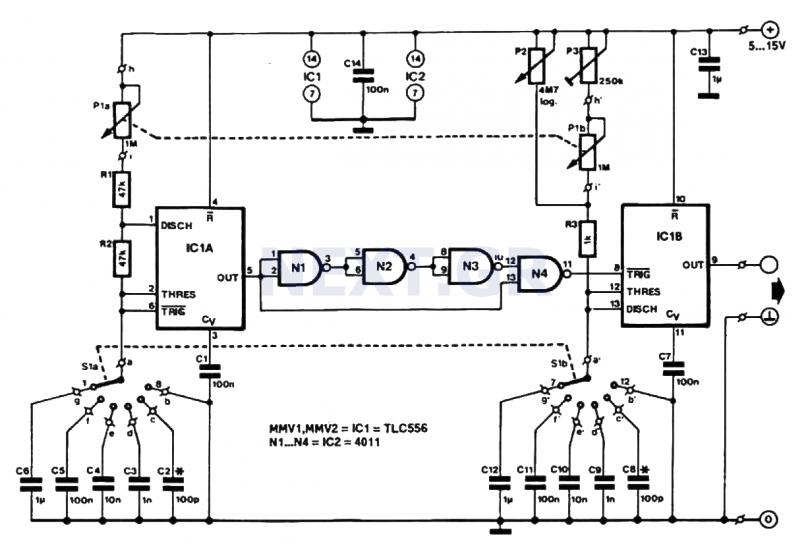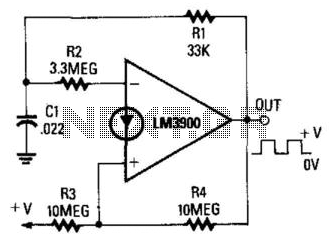
Function Generator with XR2206
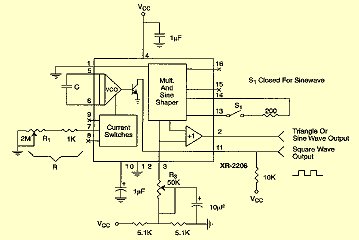
For measurement purposes in the electronics laboratory, signals of various frequencies and waveforms are frequently required. A standard function generator typically provides sine, triangular, and square wave outputs. The frequency must be adjustable and should encompass at least the low-frequency range. The low-cost integrated circuit (IC) XR2206 serves as a straightforward function generator that requires only a few external components. The XR2206 datasheet outlines a complete basic circuit for a simple function generator, which operates at a voltage of 12 V and outputs sine and square wave signals. By opening switch S1, a triangular output waveform can be obtained instead of the sine wave output. The XR2206 IC features an internal Voltage Controlled Oscillator (VCO) that produces triangular and rectangular outputs. The frequency at pin 7 is determined by the capacitor C and the power supply. Utilizing a potentiometer of 2 megohms in conjunction with a fixed resistor of 1 kOhm allows for frequency variation, providing a ratio of 1 to 2000, which can cover a range from 10 Hz to 20 kHz.
The XR2206 function generator circuit is designed to be versatile and user-friendly, making it suitable for laboratory applications where different waveform types are necessary. The circuit's core component, the XR2206 IC, is characterized by its ability to generate stable waveforms with minimal external components. The internal VCO allows for easy frequency modulation, which is essential for testing and measurement tasks.
The frequency adjustment mechanism is facilitated by the combination of the 2 megohm potentiometer and the 1 kOhm resistor. This configuration enables a wide frequency sweep, making it possible to generate low-frequency signals starting from 10 Hz, which is ideal for applications requiring low-frequency testing, such as audio equipment or low-speed digital circuits, up to 20 kHz, suitable for many general-purpose applications.
The output waveforms can be easily switched between sine, triangular, and square waves, providing flexibility to the user. The sine wave output is often used for testing linear circuits, while the square wave is useful for digital circuits and timing applications. The triangular wave output can be employed in applications such as waveform shaping and modulation.
In summary, the XR2206-based function generator circuit is a cost-effective solution for generating a variety of waveforms across a wide frequency range, making it an invaluable tool in any electronics laboratory. Its simple design, combined with the versatility of waveform generation, ensures that it meets the needs of engineers and technicians engaged in electronic testing and experimentation.For measurement purposes in the electronics laboratory is needed again and again signals of different frequency and waveforms. A common function generator provides sine, for example, triangular and square waves. The frequency must be adjustable and at least cover the low frequency range. The low-cost IC XR2206 provides a very simple function generator with only a few external components.
XR2206 data sheet provides complete basic circuit for a simple function generator. It requires an operating voltage of 12 V and delivers sine and square wave signals. Instead of the sine wave output is obtained after opening of S1 a triangular output wave. XR2206 IC contains an internal VCO (Voltage Controlled Oscillator, Voltage Controlled Oscillator) with triangular and rectangular output. The capacitor C and the power to determine the frequency at pin 7. With a pot of 2 megohms and a fixed resistor of 1 kOhm variation gives a ratio of 1 to 2000 and may include a range of 10 Hz to 20 kHz sweep
🔗 External reference
The XR2206 function generator circuit is designed to be versatile and user-friendly, making it suitable for laboratory applications where different waveform types are necessary. The circuit's core component, the XR2206 IC, is characterized by its ability to generate stable waveforms with minimal external components. The internal VCO allows for easy frequency modulation, which is essential for testing and measurement tasks.
The frequency adjustment mechanism is facilitated by the combination of the 2 megohm potentiometer and the 1 kOhm resistor. This configuration enables a wide frequency sweep, making it possible to generate low-frequency signals starting from 10 Hz, which is ideal for applications requiring low-frequency testing, such as audio equipment or low-speed digital circuits, up to 20 kHz, suitable for many general-purpose applications.
The output waveforms can be easily switched between sine, triangular, and square waves, providing flexibility to the user. The sine wave output is often used for testing linear circuits, while the square wave is useful for digital circuits and timing applications. The triangular wave output can be employed in applications such as waveform shaping and modulation.
In summary, the XR2206-based function generator circuit is a cost-effective solution for generating a variety of waveforms across a wide frequency range, making it an invaluable tool in any electronics laboratory. Its simple design, combined with the versatility of waveform generation, ensures that it meets the needs of engineers and technicians engaged in electronic testing and experimentation.For measurement purposes in the electronics laboratory is needed again and again signals of different frequency and waveforms. A common function generator provides sine, for example, triangular and square waves. The frequency must be adjustable and at least cover the low frequency range. The low-cost IC XR2206 provides a very simple function generator with only a few external components.
XR2206 data sheet provides complete basic circuit for a simple function generator. It requires an operating voltage of 12 V and delivers sine and square wave signals. Instead of the sine wave output is obtained after opening of S1 a triangular output wave. XR2206 IC contains an internal VCO (Voltage Controlled Oscillator, Voltage Controlled Oscillator) with triangular and rectangular output. The capacitor C and the power to determine the frequency at pin 7. With a pot of 2 megohms and a fixed resistor of 1 kOhm variation gives a ratio of 1 to 2000 and may include a range of 10 Hz to 20 kHz sweep
🔗 External reference
